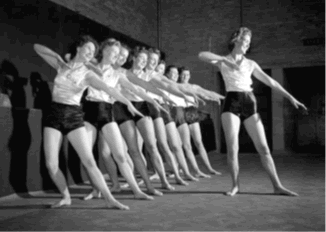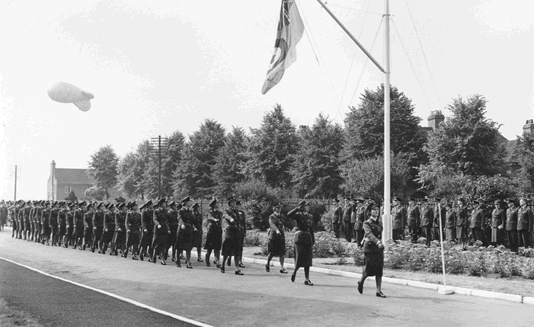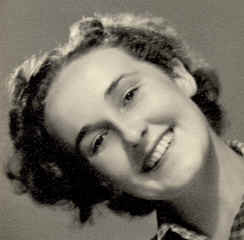Section
Officer Diana Mary Ware (307)
On
the BBRC website I posted a story about “The Very First Women's Auxiliary Air
Force Balloon Barrage Operators” in which I mentioned a W.A.A.F., Section
Officer Diana Mary Ware (307). To my surprise I was contacted by her son who was
delighted to have seen his mother mentioned. Between us we were able to
reconstruct much of her life before and after the war. She was born on 15th
March 1912 the daughter of Dr Arthur Maitland Ware and Edith Frances Maude. They
had an older daughter Ursula Frances Ware born 15th September 1910. Before
the war Diana was one of the early members of the Women’s League of Health
and Beauty, eventually becoming a Director and from 1936 was frequently
mentioned in the newspapers with various news items related to the organisation
and was in the newspapers just about every week.
She was
reported as saying that in 1936 that 90,000 women were members in Britain.

Women’s
Health & Beauty with Diana Mary Ware
On 24th October 1939 she was appointed as a Company Assistant and given a new Service Number (No. 307). This was later renamed to the title of Assistant Section Officer. She later became a Section Officer.

Section Officer
Diana Mary Ware leading the first Balloon Operators to pass out at Cardington.
On
27th March 1942 she was promoted to temporary Section Officer. On
6th May 1942 she resigned her commission on account of ill health as she had an
old injury from horse riding that was troubling her. She was a great loss to the
W.A.A.F.

She
married Squadron-Leader Adam Kropinski in March 1942 (Later Group-Captain) and
he was awarded the Virtuti Militari (1943), along three awards of the Cross of
Valour, the D.F.C., and mentioned in dispatches twice. The
family moved to Canada in the spring of 1948 and took up farming.
It
was very difficult because there was heavy rationing of clothes and food in
those days, so all my family had to join in. Food coupons had been saved
for weeks before in order to buy the few ingredients needed for a modest wedding
cake, as had clothes coupons for new shoes for me. Hats were coupon free.
There was no chance of having a wedding dress but I had an afternoon coat dress
which I wore.
I
nearly missed my wedding as the night before on going to Guildford I was caught
in an air raid in London, and spent the whole night at the railway station with
hundreds of others as the trains were stopped.
She wrote an article in Health and Beauty magazine just after leaving the W.A.A.F. and it is reproduced here.
DIANA WARE, now wife of Squadron-Leader Adam Kropinski, dates her association with the League from 1935. One of the most successful teachers, she especially excelled in public speaking and won many adherents to the League cause in speeches throughout the country.
by
DIANA WARE

It
is more than three years since I had the
privilege of contributing to this magazine – three years spent in uniform, and
not, alas, the comfortable “black and white” of pre-war days, but a more
constricting one with collar and tie, buttons and pockets and thick stockings, a
uniform which nevertheless it was an honour to wear.
I joined the W.A.A.F. in July [sic May 24] before
the outbreak of war in company with many members of my Aldershot centre.
There were then only five trades in which it was possible to serve –
motor transport driver, cook, equipment assistant, accountant clerk and mess
orderly. Now there are over fifty different trades open to women; including most
responsible and secret work, and jobs entailing a high degree of technical skill
and knowledge, such as flight mechanic and balloon operator, instrument repairer
and so on. I remember so well the
prejudice and suspicion with which this service viewed at viewed beginning.
Many of the regular R.A.F. thought that having women working on the
stations would be more of a hindrance than a help, that discipline would be
impossible to maintain, and that men and women could not work together
successfully in such close collaboration. However,
that prejudice has now entirely disappeared, and the W.A.A.F. is now an honoured
and integral part of the R.A.F. This
change of outlook was earned entirely by the conducted themselves with dignity
and pride and who proved their worth by working loyally and conscientiously
under good conditions and bad.
I
was posted to stations all over the country during my service with the W.A.A.F.,
and a very good chance it was to get to know parts of the country one would
never have had the opportunity of seeing otherwise.
Whenever I went to these widely separated camps, there were always many
League members amongst the W.A.A.F.’s. What
a splendid organisation the League is! A
lesser movement would have been defeated by the conditions of war, but this very
catastrophe has made members realise even more its true worth – the fun and
friendship of the classes which they miss so much, and the truth of the ideals
for which it stands. Being on their
own certainly developed initiative and enterprise, and members were in constant
demand for items for the station concert parties, for cabarets, by the dance
committees, and for exercise classes by other W.A.A.F.’s who were anxious
about the weight they all put on with the excellent and abundant food in the
service. At one of the largest of
the Royal Air Force stations there was a tremendous demand for a League class,
and Prunella came and gave an excellent talk and demonstration, assisted by
Margaret Davies, to the 1,000 W.A.A.F.’s there.
The following week the first class was held and the enormous gymnasium
was packed with enthusiastic airwomen in every imaginable getup, wrestling with
the intricacies of “bucking broncs” and “wiggle waggle.”
It reminded me of the Free Class at an opening demonstration.
The
most interesting and enjoyable job I had in the W.A.A.F. was being in command of
the 300 airwomen who had volunteered to take part in an experiment to see
whether women could “man” the balloon barrage.
I remember attending a conference at which it was proposed this
experiment should be made. It was
ridiculed and almost unanimously doomed to failure – “women will never stick
to a 24-hour-a-day job under such conditions,” “they won’t like getting
their hands dirty,” “they will be on duty in the front line when air raids
occur, what then?” and “you’ll never get enough volunteers even to
experiment with.” Such were the
sort of remarks that were made. However,
the senior R.A.F. officer there stuck to his proposal, and said that the
airwomen had never failed yet. “Give
them the chance to prove themselves again. When
they know that the men are urgently required elsewhere they will manage it
somehow.” Volunteers were called
for and within a few days the first 300 were chosen.
Many were disappointed because there were no more vacancies or because
they did not come up to the physical standard required.
And so, in the spring of 1941, the training of the first W.A.A.F. balloon
operators was begun. The first week
of the course is devoted to tying of knots and to rope and wire splicing.
The tests at the end showed that the average was higher than ever before.
Thus encouraged they went through the rest of the training, learning to
drive the winches and to fly the balloon in all weathers, a difficult and even
dangerous job if not handled with skill. During
the final two weeks of the course they were divided into crews of fourteen, and
they camped out in tents flying their own balloon and taking turns at sentry-go
armed with a truncheon. At the
station dances in the evenings it was difficult to recognise the smartly turned
out girl with neat hair and well cared for hands as the same one you had seen an
hour or so earlier in an oilskin coat and rubber boots, with the rain on her
face; or the pretty girl in the well pressed uniform as the one who had been on
sentry guard in the chilly early hours of that morning, and who had come to the
dance from her temporary house in a tent. How
splendid is the morale of such women! It
is something of which we may well be proud.
Now in
this winter, women in increasing numbers are helping to protect our cities and
other important targets by undertaking a man’s job, and keeping the balloon
barrage flying day and night in all sorts of weather.
As
I look back on my three years in the W.A.A.F. many incidents come to my mind
among them humorous, though somewhat embarrassing times, such as when, as a very
junior officer, I visited one of the Messes, and seeing a bowl of orange-looking
liquid I congratulated the R.A.F. Sergeant cook on the appearance of his tomato
soup, only to be told in a cold voice: “That is tea, madam.”
I feel admiration, as I remember the hundreds of women who have
volunteered –unselfishly for the jobs with the least glamour, scrubbing floors
and keeping the stations the clean and pleasant places they always are.
I feel proud when I remember the impressive passing out parade of those
first 300 balloon operators, marching behind their own band; and when I think of
the telephone operators and others who stuck to their place of duty when bombs
were falling all round. Such things
are not peculiar to the W.A.A.F. They
are typical of what is happening in all the women’s services, in the factories
and on the land. No wonder visitors
to these islands stand amazed at the magnificent part women are playing in our
effort for victory.
And when the war is over, what then? Will this willingness to serve, this great unselfish effort, this splendid expression of patriotism disintegrate and fade away? It is for us to decide. It is not too much to say that on our answer depends the outcome of the battle for Peace.
Diana continued teaching the Women’s League of Health & Beauty exercises, until she was 80 years old.